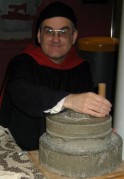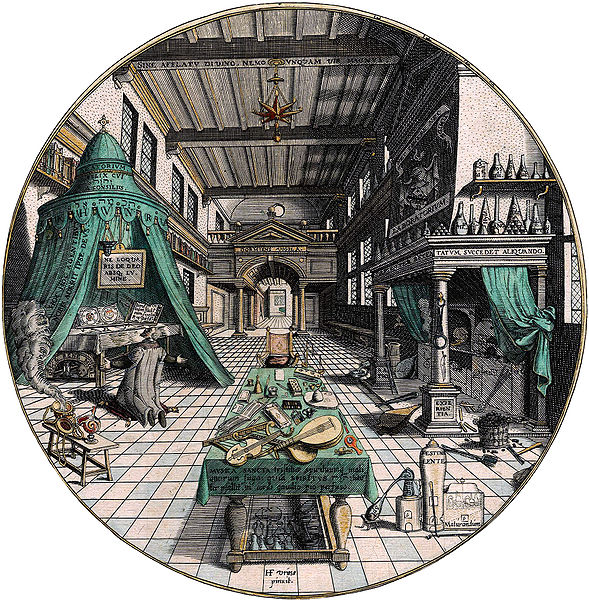by Graham J. Darling (as Doctor Carus of Burn Abbey, Barony of Lions Gate). First published in North Wind, 2012 Aug-Sept, n° 349, p 7-8.
Dear Dr. Carus,
So you’re an alchemist in the year 1300? Aren’t you worried you’ll be burned at the stake?
Signed,
A Mob of Peasants With Torches
Dear Mob,
Friends, Lions Gaters, countrymen, lend me your ears!
From time to time the question arises about the role of the Natural Philosopher in the Church (most of us being Clergy or Religious Brothers & Sisters, after all), and in Society at large, and why your tithe dollars should go towards me nosing through old books and writing new ones, making bad smells, and possibly disrupting our cherished Way of Life.
I’ve mentioned before the legend of Emperor Tiberius executing an alchemist to suppress the secret of vitrum flexile [1] – malleable glass, that neither rusts nor rots nor shatters, and therefore would have threatened to replace gold, and so devalue the Imperial Reserve. A similar blow against possible inflation – and to punish a rebellion, and forestall the funding of others – may have been behind the pagan Emperor Diocletan’s decree around 290 AD that all alchemy books in the Library of Alexandria be sought out and burned [2]. After Alchemy reached the Europe in the 12th century (after a respected sojourn amongst the Muslims), various rulers did feel obliged to legislate against it: Pope John XXII in his Bull Spondent quas non exhibent (1317) – but this was specifically against fraudulent claims of transmutation (for which Dr Carus heartily approves the traditional punishment of hanging ’em high on a gilded scaffold; China had issued a similar law in 144 BC); Charles V of France (1380) – but he kept his own “scientific consultant” on the premises, Thomas of Bologna; and Henry IV of England (1404) – again, a ban restricted to “multiplication”, and part of a series of laws against debasing the coinage, the export of gold and silver, and to otherwise keep precious metals under royal control, while Henry VI (1421-1471) was regularly granting alchemy licenses not long after. Meanwhile, “alchemy” in the wider sense of “chemical technology” was undeniably advancing many new and useful products – alcohol, gunpowder, Greek Fire (until the secret was lost again), soap, pigments, laudanum, brass, etc etc [3], so that Francis Bacon was eventually moved to write even of the (as he believed, by then) “false science” of transmutation:
“Alchemy may be compared to the man who told his sons that he had left them gold buried somewhere in his vineyard; where they by digging found no gold, but by turning up the mould about the roots of the vines, procured a plentiful vintage. So the search and endeavours to make gold have brought many useful inventions and instructive experiments to light.” [4]
By that time pet Royal Alchemists were fairly routine – Elizabeth I (1533-1603) had John Dee and Edward Kelley; James IV of Scotland (1473-1513) had John Damian; Christian II of Saxony (1583-1611) captured alchemist Alexander Seton and tried to extract his secrets by torture; Holy Roman Emperor Rudolf II (1552-1612) and Charles II of England (1630-1685) each had their own personal laboratories. Scientists best known in other fields, like astronomer Tycho Brahe (1546-1601), physicist Isaac Newton (1642-1727), and even “real chemist” Robert Boyle (1627-1691) were more than mere dabblers in this field.

On the religious front, the medieval Church had no problem in principle with Natural Science, and St Augustine of Hippo (354-430 AD) early cautioned that one should not interpret Scripture in ways that flatly contradict what people already know from other reliable sources, but should even be ready to revise current biblical exegesis as new information comes to light [5]. St Anselm (1033-1109), Peter Abelard (1079-1142) and Robert Grosseteste (1170–1253) reiterated the compatibility of faith and reason, and prepared the way for both the “new learning” of Aristotle and other pagan and Muslim authors, and its verification and correction by further thought and experiment; while St Albertus Magnus (1193-1280), St Thomas Aquinas (1225-1274) and especially Roger Bacon (1214–1294) lobbied specifically for alchemy as a legitimate scholarly pursuit, and a lawful weapon to dispel the illusions and other foul magics of the Antichrist when he should appear. Thus when individual alchemists, such as Arnaldus de Villanova (1235–1311), did run afoul of ecclesiastical authorities, it was for making theological/political pronouncements outside their discipline, and without compelling evidence; thus, Philip II (1554-1598) welcomed alchimists even as he intensified the Spanish Inquisition; thus when, amidst the panic of the Little Ice Age, Pope Innocent VIII issued the Bull Summis desiderantes affectibus (1484) that gave license to the witch-hunts of the Renaissance (that also proved a “Renaissance” of the basest fears, as well as the loftiest thoughts, of earlier eras), he was careful to exempt alchemy and other natural sciences (of which he remained a patron) as not (necessarily) involving necromancy, deviltry, heresy, nor similar practices that imperilled the social fabric and the soul. And later writers could further testify not only to the moral innocence of alchemy (well, maybe besides its military uses… and drug abuses… then there was that Affair of the Poisons in France 1677-1682…), but to its power to Inspire:
“The science of alchymy I like well, and, indeed, ’tis the philosophy of the ancients. I like it not only for the profits it brings in melting metals, in decocting preparing, extracting, and distilling herbs, roots; I like it also for the sake of the allegory and secret signification, which is exceedingly fine, touching the resurrection of the dead at the last day.” Martin Luther [6]
“Therefore David who was metal tried seven times in the fire, and desired to be such gold as might be laid up in God’s treasury, might consider, that in the transmutation of metals, it is not enough to come to a calcination or a liquefaction of the metal… nor to an ablution, to sever dross from pure, not to a transmutation, to make it a better metal, but there must be a fixion, a settling thereof, so that it shall not evaporate into nothing, nor return to his former state. Therefore he saw that he needed not only a liquefaction, a mealting into tears, not only an ablution, and a transmutation, those he had by this purging and this washing… but he needed fixionem, and establishment. Or here, where the action of the Stone in transmutation parallels the redemptive mission of Christ and the healing power of His sacrificial blood as the Philosopher’s Stone…has virtue by means of its tincture and its developed perfection to change other imperfect and base metals into pure gold, so our Heavenly King and fundamental Corner Stone, Jesus Christ, can alone purify us sinners and imperfect men with His Blessed ruby-colored Tincture, that is to say, His Blood.” John Donne [7]
References:
1. Pliny the Elder Naturalis Historia / Natural History, 79 AD, book 36, ch 66.
2. Edward Gibbon The History of the Decline and Fall of the Roman Empire, 1776, vol 1, ch 13; Dr Carus cannot share this author’s appproval of such burning, on any grounds!
3. T.O. Sloane “Alchemy”, The Catholic Encyclopedia, 1907, vol 1; F. Gies F & J. Gies Cathedral, Forge and Waterwheel, 1994; E.J. Holmyard Alchemy, 1957.
4. Francis Bacon De Augmentis Scientiarum / On the Advancement of Learning, 1623, book 1, ch 4, s 11.
5. St. Augustine of Hippo De Genesi ad litteram / On the Literal Meaning of Genesis, 415 AD, book 1, ch 18-19; see also D.A. Young “The Contemporary Relevance of Augustine’s View of Creation”, Perspectives on Science and Christian Faith, 1988 March, vol 40, n° 1, p 142-45.
6. Martin Luther Tischreden / Table Talk, 1566, n° 740 ; his third son Paul taught the subject.
7. John Donne “On the Penitential Psalms”, Sermons, ca. 1620, sermon 62; see also E.H. Duncan “Donne’s Alchemical Figures”, ELH, 1942 March, vol 9, n°1, p 257-285; J.A. Mazzeo, “Notes on John Donne’s Alchemical Imagery”, Isis, 1957, vol 48, p 103-123.